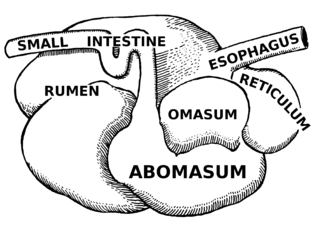 W
WThe abomasum, also known as the maw, rennet-bag, or reed tripe, is the fourth and final stomach compartment in ruminants. It secretes rennet, which is used in cheese creation.
 W
WAkidolestes is an extinct genus of spalacotheriid mammal.
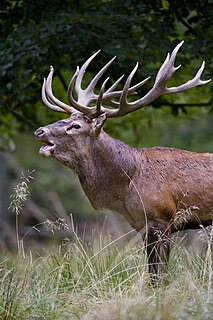 W
WAntlers are extensions of an animal's skull found in members of the deer family. Antlers are a single structure composed of bone, cartilage, fibrous tissue, skin, nerves, and blood vessels. They are generally found only on males, with the exception of the reindeer/caribou. Antlers are shed and regrown each year and function primarily as objects of sexual attraction and as weapons in fights between males for control of harems.
 W
WThe baculum is a bone found in the penis of many placental mammals. It is absent in the human penis, but present in the penises of other primates, such as the gorilla and chimpanzee. The os penis arises from primordial cells within soft tissues of the penis, and its formation is largely under the influence of androgens. The bone is located above the male urethra, and it aids sexual reproduction by maintaining sufficient stiffness during sexual penetration. The homologue to the baculum in female mammals is known as the baubellum or os clitoridis, a bone in the clitoris.
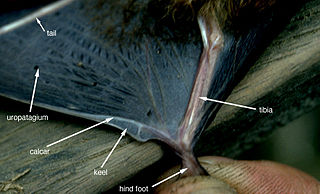 W
WThe calcar, also known as the calcaneum, is the name given to a spur of cartilage arising from inner side of ankle and running along part of outer interfemoral membrane in bats, as well as to a similar spur on the legs of some arthropods.
 W
WIn mammalian oral anatomy, the canine teeth, also called cuspids, dog teeth, or fangs, eye teeth, vampire teeth, or vampire fangs, are the relatively long, pointed teeth. They can appear more flattened however, causing them to resemble incisors and leading them to be called incisiform. They developed and are used primarily for firmly holding food in order to tear it apart, and occasionally as weapons. They are often the largest teeth in a mammal's mouth. Individuals of most species that develop them normally have four, two in the upper jaw and two in the lower, separated within each jaw by incisors; humans and dogs are examples. In most species, canines are the anterior-most teeth in the maxillary bone.
 W
WCarnassials are paired upper and lower teeth modified in such a way as to allow enlarged and often self-sharpening edges to pass by each other in a shearing manner. The modification arose separately in several groups of carnivorous mammals. Different pairs of teeth were involved in the separate modifications. In modern Carnivora, the carnassials are the modified fourth upper premolar and the first lower molar. These teeth are also referred to as sectorial teeth. Humans lack carnassial teeth.
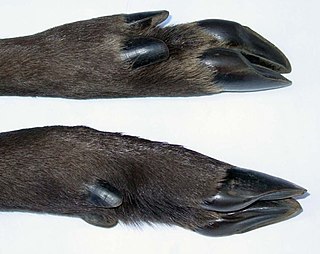 W
WA cloven hoof, cleft hoof, divided hoof or split hoof is a hoof split into two toes. This is found on members of the mammalian order Artiodactyla. Examples of mammals that possess this type of hoof are cattle, deer, pigs, antelopes, gazelles, goats and sheep. In folklore and popular culture, a cloven hoof has long been associated with the Devil.
 W
WIn zoology, a club is a bony mass at the end of the tail of some dinosaurs and of some mammals, most notably the ankylosaurids and the glyptodonts, as well as meiolaniid turtles. It is thought that this was a form of defensive armour or weapon that was used to defend against predators, much in the same way as a thagomizer, possessed by stegosaurids, though at least in glyptodonts it is hypothesized it was used in fighting for mating rights. Among dinosaurs, the club was present mainly in ankylosaurids, although the sauropod Shunosaurus also possessed a tail club. The tail club is most often depicted on Ankylosaurus, especially in encounters with larger predators such as Tyrannosaurus. Victoria Arbour has established that ankylosaurid tails could generate enough force to break bone during impacts.
 W
WCorneous is a biological and medical term meaning horny, in other words made out of a substance similar to that of horns and hooves in some mammals.
 W
WThe deep fascia of leg, or crural fascia forms a complete investment to the muscles, and is fused with the periosteum over the subcutaneous surfaces of the bones.
 W
WDentition pertains to the development of teeth and their arrangement in the mouth. In particular, it is the characteristic arrangement, kind, and number of teeth in a given species at a given age. That is, the number, type, and morpho-physiology of the teeth of an animal.
 W
WThe evolution of mammalian auditory ossicles was an evolutionary event that resulted in the formation of the bones of the mammalian middle ear. These bones, or ossicles, are a defining characteristic of all mammals. The event is well-documented and important as a demonstration of transitional forms and exaptation, the re-purposing of existing structures during evolution.
 W
WMammals normally have a pair of eyes. Although mammalian vision is not so excellent as bird vision, it is at least dichromatic for most of mammalian species, with certain families possessing a trichromatic color perception.
 W
WFur is a thick growth of hair that covers the skin of many different animals. It is a defining characteristic of mammals. It consists of a combination of oily guard hair on top and thick underfur beneath. The guard hair keeps moisture from reaching the skin; the underfur acts as an insulating blanket that keeps the animal warm.
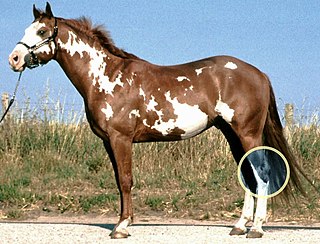 W
WThe hock, or gambrel, is the joint between the tarsal bones and tibia of a digitigrade or unguligrade quadrupedal mammal, such as a horse, cat, or dog. This joint may include articulations between tarsal bones and the fibula in some species, while in others the fibula has been greatly reduced and is only found as a vestigial remnant fused to the distal portion of the tibia. It is the anatomical homologue of the ankle of the human foot. While homologous joints occur in other tetrapods, the term is generally restricted to mammals, particularly long-legged domesticated species.
 W
WA hoof, plural hooves or hoofs, is the tip of a toe of an ungulate mammal, strengthened by a thick and horny keratin covering.
 W
WA horn is a permanent pointed projection on the head of various animals that consists of a covering of keratin and other proteins surrounding a core of live bone. Horns are distinct from antlers, which are not permanent. In mammals, true horns are found mainly among the ruminant artiodactyls, in the families Antilocapridae (pronghorn) and Bovidae. Cattle horns arise from subcutaneous connective tissue and later fuse to the underlying frontal bone.
 W
WThe hyoid apparatus is the collective term used in veterinary anatomy for the bones which suspend the tongue and larynx. It consists of pairs of stylohyoid, thyrohyoid, epihyoid and ceratohyoid bones, and a single basihyoid bone. The hyoid apparatus resembles the shape of a trapeze, or a bent letter "H". The basihyoid bone lies within the muscle at the base of the tongue.
 W
WTeeth are common to most vertebrates, but mammalian teeth are distinctive in having a variety of shapes and functions. This feature first arose among the Therapsida during the Permian, and has continued to the present day. All Therapsid groups with the exception of the mammals are now extinct, but each of these groups possessed different tooth patterns, which aids with the classification of fossils.
 W
WA mammary gland is an exocrine gland in humans and other mammals that produces milk to feed young offspring. Mammals get their name from the Latin word mamma, "breast". The mammary glands are arranged in organs such as the breasts in primates, the udder in ruminants, and the dugs of other animals. Lactorrhea, the occasional production of milk by the glands, can occur in any mammal, but in most mammals, lactation, the production of enough milk for nursing, occurs only in phenotypic females who have gestated in recent months or years. It is directed by hormonal guidance from sex steroids. In a few mammalian species, male lactation can occur. With humans, male lactation can occur only under specific circumstances.
 W
WThe modified triadan system is a scheme of dental nomenclature that can be used widely across different animal species. It is used worldwide among veterinary surgeons.
 W
WThe nipple is a raised region of tissue on the surface of the breast from which, in females, milk leaves the breast through the lactiferous ducts to feed an infant. The milk can flow through the nipple passively or it can be ejected by smooth muscle contractions that occur along the ductal system. The nipple is surrounded by the areola, which is often a darker color than the surrounding skin. A nipple is often called a teat when referring to non-humans. Nipple or teat can also be used to describe the flexible mouthpiece of a baby bottle. In humans, nipples of both males and females can be stimulated as part of sexual arousal. In many cultures, human female nipples are sexualized, or "regarded as sex objects and evaluated in terms of their physical characteristics and sexiness."
 W
WThe omasum, also known as the bible, the fardel, the manyplies and the psalterium, is the third compartment of the stomach in ruminants. The omasum comes after the rumen and reticulum and before the abomasum. Different ruminants have different omasum structures and function based on the food that they eat and how they developed through evolution.
 W
WOssicones are horn-like or antler-like protuberances on the heads of giraffes, male okapis, and their extinct relatives, such as Sivatherium, and the climacoceratids, such as Climacoceras. It has been argued that these extinct species did not have true ossicones; however, later research has revealed their ossicones to be in line with those of giraffids. Ossicones are located dorsally of the frontal bone and fuse to the skull later in life.
 W
WThe patagium is a membranous structure that assists an animal in gliding or flight. The structure is found in living and extinct groups of animals including bats, birds, some dromaeosaurs, pterosaurs, gliding mammals, some flying lizards, and flying frogs. The patagium that stretches between an animal's hind limbs is called the uropatagium or the interfemoral membrane.
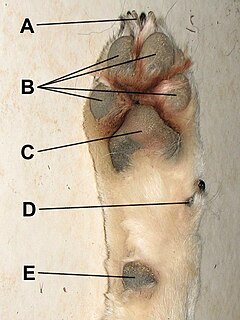 W
WA paw is the soft foot-like part of a mammal, generally a quadruped, that has claws.
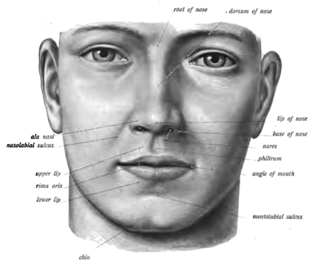 W
WThe philtrum, or medial cleft, is a vertical indentation in the middle area of the upper lip, common to many mammals, extending in humans from the nasal septum to the tubercle of the upper lip. Together with a glandular rhinarium and slit-like nostrils, it is believed to constitute the primitive condition for at least therian mammals. Monotremes lack a philtrum, though this could be due to the specialised, beak-like jaws in living species.
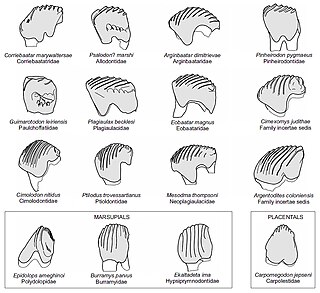 W
WA plagiaulacoid is a type of blade-like, most often serrated, tooth present in various mammal groups, usually a premolar. Among modern species it is present chiefly on diprotodontian marsupials, which have both the upper and lower first premolars converted into serrated blades. However, various other extinct groups also possessed plagiaulacoids. These would be multituberculates, some "Plesiadapiformes" such as Carpolestes and various metatherians such as Epidolops and various early diprotodontians. In many of these only a lower premolar became converted into a blade, while the upper premolars showed less speciation.
 W
WThe preorbital gland is a paired exocrine gland found in many species of hoofed animals, which is homologous to the lacrimal gland found in humans. These glands are trenchlike slits of dark blue to black, nearly bare skin extending from the medial canthus of each eye. They are lined by a combination of sebaceous and sudoriferous glands, and they produce secretions which contain pheromones and other semiochemical compounds. Ungulates frequently deposit these secretions on twigs and grass as a means of communication with other animals.
 W
WThe rhinarium is the furless skin surface surrounding the external openings of the nostrils in many mammals. Commonly it is referred to as the tip of the snout, and breeders of cats and dogs sometimes use the term nose leather. Informally, it may be called a "truffle", "wet snout" or "wet nose," because its surface is moist in some species: for example, healthy dogs and cats.
 W
WThe rump or croup, in the external morphology of an animal, is the portion of the posterior dorsum – that is, posterior to the loins and anterior to the tail. Anatomically, the rump corresponds to the sacrum.
 W
WScent glands are exocrine glands found in most mammals. They produce semi-viscous secretions which contain pheromones and other semiochemical compounds. These odor-messengers indicate information such as status, territorial marking, mood, and sexual power. The odor may be subliminal—not consciously detectable. Though it is not their primary function, the salivary glands may also function as scent glands in some animals.
 W
WThe supratrochlear foramen is a small hole located above the trochlea of the humerus of several mammals, it is found frequently in dogs and sometimes in humans, especially women and in the left humerus. It is covered by a layer of connective tissue.
 W
WThe thymus is a specialized primary lymphoid organ of the immune system. Within the thymus, Thymus cell lymphocytes or T cells mature. T cells are critical to the adaptive immune system, where the body adapts specifically to foreign invaders. The thymus is located in the upper front part of the chest, in the anterior superior mediastinum, behind the sternum, and in front of the heart. It is made up of two lobes, each consisting of a central medulla and an outer cortex, surrounded by a capsule.
 W
WTusks are elongated, continuously growing front teeth that protrude well beyond the mouth of certain mammal species. They are most commonly canine teeth, as with pigs, hippos, and walruses, or, in the case of elephants, elongated incisors. In most tusked species both the males and the females have tusks although the males' are larger. Most mammals with tusks have a pair of them growing out from either side of the mouth. Tusks are generally curved and have a smooth, continuous surface. The narwhal's straight single helical tusk, which grows out from the center of the mouth and is present only in the male, is an exception to the typical features of tusks described above. Continuous growth of tusks is enabled by formative tissues in the apical openings of the roots of the teeth. Prior to over hunting and proliferation of the ivory trade, elephant tusks weighing over 90 kg (200 lb) were not uncommon, though it is rare today to see any over 45 kg (100 lb).
 W
WAn udder is an organ formed of two or four mammary glands of dairy animals and ruminants such as cattle, goats, and sheep. An udder is equivalent to the breast in primates. The udder is a single mass hanging beneath the animal, consisting of pairs of mammary glands with protruding teats. In cattle, there are normally two pairs, in sheep, goats and deer, there is one pair, and in some animals, there are many pairs. In animals with udders, the mammary glands develop on the milk line near the groin, and mammary glands that develop on the chest are generally referred to as breasts.
 W
WWhiskers or vibrissae are a type of mammalian hair that are typically characterised, anatomically, by their long length, large and well-innervated hair follicle, and by having an identifiable representation in the somatosensory cortex of the brain.
 W
WA wing is a type of fin that produces lift, while moving through air or some other fluid. As such, wings have streamlined cross-sections that are subject to aerodynamic forces and act as airfoils. A wing's aerodynamic efficiency is expressed as its lift-to-drag ratio. The lift a wing generates at a given speed and angle of attack can be one to two orders of magnitude greater than the total drag on the wing. A high lift-to-drag ratio requires a significantly smaller thrust to propel the wings through the air at sufficient lift.
 W
WIn rodent anatomy, the zygomatic plate is a bony plate derived from the flattened front part of the zygomatic arch (cheekbone). At the back, it connects to the front (maxillary) root of the zygomatic arch, and at the top it is connected to the rest of the skull via the antorbital bridge. It is part of the maxillary bone, or upper jaw, which also contains the upper cheekteeth. Primitively, rodents have a nearly horizontal zygomatic plate. In association with specializations in zygomasseteric system, several distinct morphologies have developed across the order.